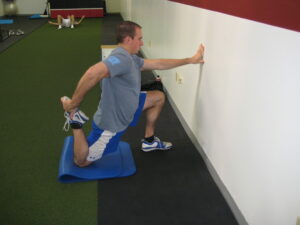Pulled Quad – or is it?
Q: How should I warm up properly before sprinting sessions? Back in the day when I did sports my quads were always prone to injuries. Funny thing is I haven’t had any problems when doing squats of any kind. Recently I decided to involve some alactic work in my workout and immediately pulled a quad doing sprints. It’s obviously something wrong with my warm-up!
A: Saying “pulled quad” might be a little bit too general. In reality, most of the time, you’re looking at a rectus femoris strain. While it is one of the quadriceps, the rectus femoris is also active as a hip flexor. So, as the picture below shows, it crosses two joints.
The rectus femoris is responsible for both hip flexion and knee extension. So, as you can imagine, it is placed on a huge stretch when an athlete goes into a position of hip extension and knee flexion – kind of like this:

You’re asking the rectus femoris to go on a huge stretch there – and under very high velocities. With a squat, you’re not putting it on full stretch, as the hip and knee are both flexed. So, with that in mind, it’s not surprising at all that sprinting would bother your “quad” when squatting doesn’t – especially since we know the overwhelming majority of folks out there are tight in the rectus femoris. Why?
Well, first, you don’t need to be a rocket scientist to know that, as a society, we sit far too much. Second, though, is the fact that most people never really get above 90 degrees of hip flexion in anything that they do. Mike Boyle has done a great job of outlining how we can develop imbalanced hip flexion patterns; essentially, we never use our psoas, the only hip flexor active above 90 degrees of hip flexion. The picture below is kind of rudimentary (and somewhat awkward), but it shows what I’m getting at with respect to the advantageous attachment points for psoas with respect to hip flexion above 90 degrees:
How many of the folks at your gym are getting 90+ degrees of hip flexion with their treadmill, stairclimber, and elliptical work? None. So, we underuse psoas, and overuse rectus – and it shortens up over time. Take a short muscle through a maximal stretch at high-velocities, and it’s going to hate you. So, what to do?
Well, first, I’d recommend running through some warm-ups from Assess and Correct, and that’ll cover a lot of the fundamentals (especially if you go through the assessments to figure out what else is going on). One important thing that’ll cover is activation work for psoas; Kevin Neeld demonstrates one option here:
Second, just add in some targeted static stretching for the rectus femoris a few times a day using this stretch (don’t start using it until the “pulled quad” has settled down, though).

Third, and most importantly, ease your way into sprinting. Not everyone is prepared to just jump right in full-throttle. I discuss this in further detail in my contribution to the most recent Mythbusters article at T-Nation. Basically, just get out there twice a week and do some 60-yd build-ups at 80% of your best on a grass field.
Sign-up Today for our FREE newsletter and receive a deadlift technique video!




